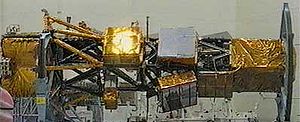 An image released by the NRO, reportedly showing a Lacrosse satellite under construction. | |
| Manufacturer | Lockheed Martin |
|---|---|
| Country of origin | United States |
| Operator | U.S. National Reconnaissance Office |
| Applications | Radar imaging |
| Specifications | |
| Regime | Low Earth |
| Production | |
| Status | Out of Production |
| Built | 5 known |
| Launched | 5 |
| Operational | 0 |
| Retired | All |
| Maiden launch | USA-34, 1988-12-02 |
| Last launch | USA-182, 2005-04-30 |
Lacrosse or Onyx was a series of terrestrial radar imaging reconnaissance satellites operated by the United States National Reconnaissance Office (NRO). While not officially confirmed by the NRO or the Government of the United States prior to 2008, there was widespread evidence pointing to its existence, including one NASA website.[1] In July 2008, the NRO itself declassified the existence of its synthetic aperture radar (SAR) satellite constellation.[2][3]
According to former Director of Central Intelligence Admiral Stansfield Turner, Lacrosse had its origins in 1980 when a dispute between the Central Intelligence Agency and the U.S. Air Force as to whether a combined optical/radar reconnaissance satellite (the CIA proposal) or a radar-only one (the USAF proposal) should be developed was resolved in favor of the USAF.[citation needed]
Lacrosse uses synthetic aperture radar as its prime imaging instrument.[4][5] It is able to see through cloud cover and also has some ability to penetrate soil,[citation needed] though there have been more powerful instruments deployed in space for this specific purpose[specify]. Early versions are believed to have used the Tracking and Data Relay Satellite System (TDRSS) to relay imagery to a ground station at White Sands, New Mexico.[6] There are some indications that other relay satellites may now be available for use with Lacrosse. The name Lacrosse is used to refer to all variants, while Onyx is sometimes used to refer to the three newer units.[citation needed]
Unit costs (including launch) in 1990 dollars are estimated to be in the range of US$0.5 to 1.0 billion.[7]
- ^ NASA – NSSDC – Spacecraft – Details
- ^ "DoD Buzz | Spy Radar Satellites Declassified". Archived from the original on 2016-10-28. Retrieved 2010-02-17.
- ^ "NRO Almanac" (PDF). DTIC. January 2011. Retrieved February 9, 2023.
- ^ Lacrosse / Onyx
- ^ Ups and Downs of Space Radars
- ^ "Spy Satellites: Entering a New Era" (PDF). Science. 24 March 1989. Retrieved 20 July 2013.
- ^ "U.S. Costs of Verification and Compliance Under Pending Arms Treaties (CBO Publication #528)" (PDF). CONGRESSIONAL BUDGET OFFICE, CONGRESS OF THE UNITED STATES. September 1990.